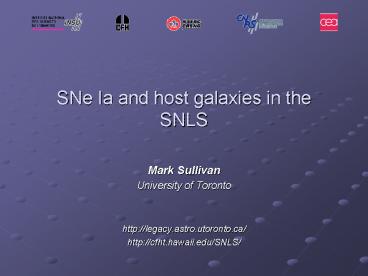SNe Ia and host galaxies in the SNLS PowerPoint PPT Presentation
1 / 18
Title: SNe Ia and host galaxies in the SNLS
1
SNe Ia and host galaxies in the SNLS
- Mark Sullivan
- University of Toronto
- http//legacy.astro.utoronto.ca/
- http//cfht.hawaii.edu/SNLS/
2
Host galaxies impact SN properties
SN Ia Light-curve shape depends on morphology
e.g. Hamuy et al. (2000)
Low stretch
High stretch
Some evidence that SNe Ia in ellipticals show
smaller scatter
Sullivan et al. (2003)
3
Typing of SNLS SN Ia hosts
- Little morphological information available
- CFHT ugriz imaging via the Legacy program.
- PEGASE2 is used to fit SED templates to the
optical data. - Recent star-formation rate, total stellar mass,
mean age are estimated. - Hosts classified according to physical
parameters instead of what they look like.
Passive
Star-forming
Starbursting
Sullivan et al. (2006)
4
Spec-z/Phot-z for host galaxies
All SN hosts brighter than i25
(Vega) ?z/(1z)0.042
5
SNLS SN rate as a function of sSFR
SN Ia hosts classified by star-formation
activity Per unit stellar mass, SNe are at least
an order of magnitude more common in more
vigorously star-forming galaxies
SNLS passive galaxies
Efficiencies from Neill et al. (2006) (see SDSS
talk)
6
SNLS selection of hosts
- D2 ACS imaging
- Plenty of irregular/late-type systems
- Few genuine ellipiticals
7
SN Ia Stretch dependencies
Stretch by galaxy star-formation activity
Stretch versus mean age
The majority of SN Ia come from young stellar
populations
Star-forming
Passive
170 SNe Ia (Update from Sullivan et al. 2006
better zeropoints, host photometry, more SNe)
8
Recent SNLS evidence for two components for SNe Ia
Older progenitor SNe Empirically, SN Rate is
proportional to galaxy mass Preferentially
found in old stellar environments Typically
fainter with faster light-curves (low stretch)
Younger progenitor SNe Empirically, SN rate is
proportional to galaxy star formation
rate Exclusively found in later type
star-forming galaxies Typically brighter with
slower light-curves (high stretch) (Extreme
example SNLS-03D3bb?)
Two component model discussed in Mannucci et al.
2006, 2006 Scannapieco Bildsten 2006 Sullivan
et al. 2006 etc.
9
SN population drift?
- Relative mix of evolves with redshift
- AB predictions, but similar for any two
component model
Sullivan et al. 2006
10
Stretch versus redshift (3rd year)
?
11
Effect of selection on stretch-redshift
Simulations of SNLS completeness including
detection and spectroscopic selection (Perrett et
al. in prep)
Mean Stretch
Redshift
12
Evolution in Stretch? Gaussians predicted
evolution from AB model Average stretch, and
thus average intrinsic brightness of SNe Ia
evolves with redshift but if stretch correction
works perfectly, this should not affect cosmology
Nearby
zlt0.75
zgt0.75
Howell et al. 2007
13
Split by s (preliminary)
14
Stretch correction across environments
Rest-frame B composite light-curve
- Conley et al. 2006
No evidence for gross differences between
light-curves in passive and active galaxies
15
Split by host galaxy
SN Subsets
Passive
s0.10 mag
Star-forming
s0.14 mag
Preliminary
Problems Low-redshift sample very small,
Malmquist correction likely to be different
16
Stretch residuals (preliminary)
17
Colour residuals (preliminary)
18
Summary
- SNe Ia have a range of progenitor ages
- Impacts on light-curve shape faster/older
slower/younger - SNe in passive galaxies are better standard
candles? - More homogeneous stellar population? Less dust?
- Can large samples of local SNe in elliptical
galaxies break the colour degeneracy?

